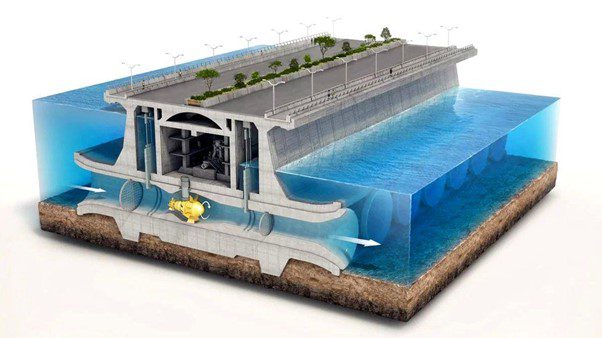
The zero-carbon deep-sea automated container terminal will be capable of processing between 1,500,000 and 4,000,000 containers annually and will handle the world’s largest container ships, feeder services and roll-on roll-off vessels (Ro-Ro).
The proposal includes constructing a hydroelectric structure within the project, which will capture the incoming and outgoing tides twice a day, providing entirely predictable energy for the terminal and up to 600,000 homes and businesses in the region.

Agreed on a strategic partnership
Centre Port Holdings has agreed on a strategic partnership with the UK’s leading energy company Centrica, which has invested in the seed round, allowing Centre Port to engage environmental and technical consultancies to begin work on a feasibility study.
Centrica would provide a guaranteed price for the renewable energy produced by the tidal turbines to underpin their construction. It’s anticipated that some of the peak renewable energy produced could be used to create green hydrogen to decarbonise the farming and transport sector.

The structure will act as a flood defence scheme against exceptional tides resulting from climate change, which would otherwise damage sensitive habitats and wildlife in The Wash estuary.
One-third of the UK’s vegetable production
The turbine sluice gates built within the structure will protect vital farmland, homes and industry against landside flooding and tidal surges across Lincolnshire, Norfolk, and Cambridgeshire, which generates a third of the UK’s vegetable production.

It’s expected that the scheme will create 1000+ jobs during construction and, once completed, will attract significant employment opportunities in manufacturing, maritime, transportation, port operations and green industries to the region. Furthermore, there will be possibilities for recreational activities such as safe sailing/water sports and marinas in the Wash with Centre Port in place.
State-of-the-art rail facility
Centre Port will champion levelling up opportunities in coastal towns and villages, improving transport links with the connection between south Lincolnshire and north Norfolk by providing a 20-minute alternative to the congested A17. The container terminal will have a state-of-the-art rail facility linking into the Skegness – Birmingham Rail line to carry up to 40% of the container traffic.
James Sutcliffe, CCEO at Centre Port Holdings, said: “Centre Port is a multiple income generating development where decarbonising the logistics chain is a priority in today’s world.
“Centre Port provides multiple business opportunities and a lower/ zero carbon operation across the import /export chain whilst also being 50% nearer the East and West Midlands it serves.
“It is well placed to drive new economic opportunities in Lincolnshire/ Norfolk and Cambridge, job creation and Levelling up in local communities that are otherwise reliant on the agricultural sector.
A reliable source of green energy
“The local environment is seriously at risk from climate change. Our Mission is to retain the Wash boundaries, its wildlife and ecology and to minimise climate change impacts that could devastate these sensitive areas.”
Greg McKenna, managing director of Centrica Business Solutions, said: “We’re excited to help Centre Port explore their ambitious plans for the Wash. The project represents one of the largest tidal power schemes anywhere in the world and provides a reliable source of green energy to the UK. The first step is to understand the role such a scheme would play in an area of the country particularly vulnerable to the effects of climate change.”